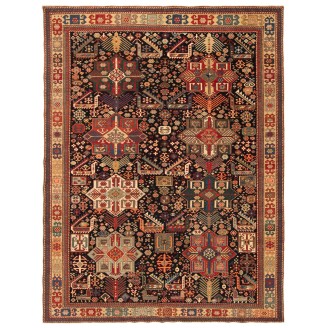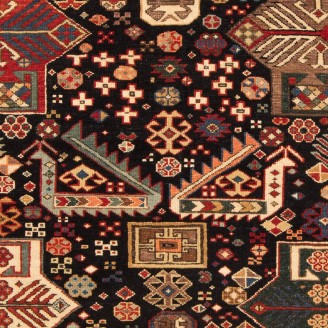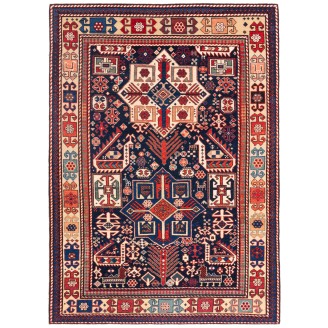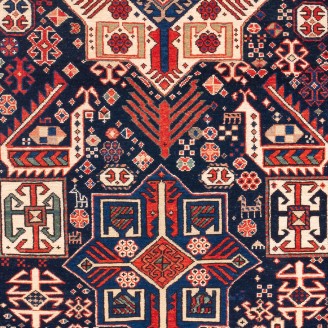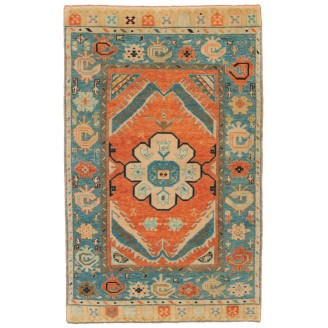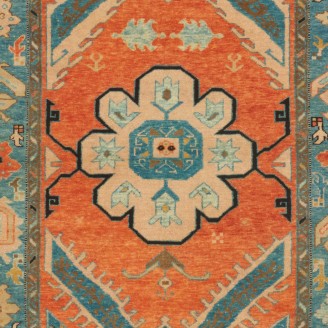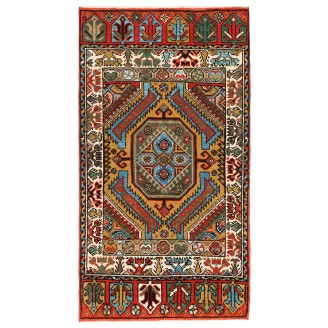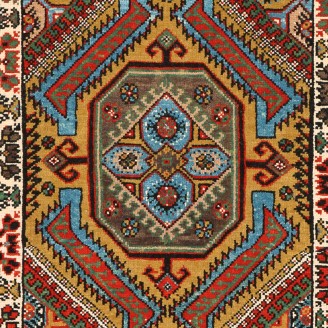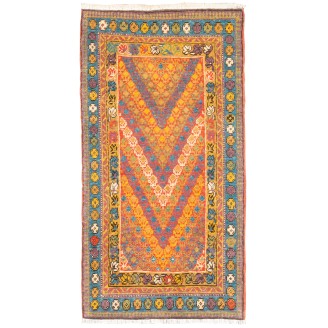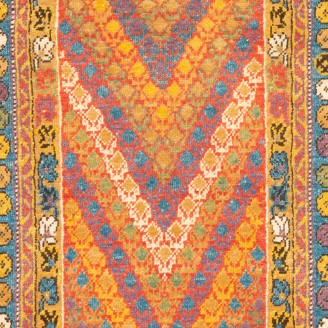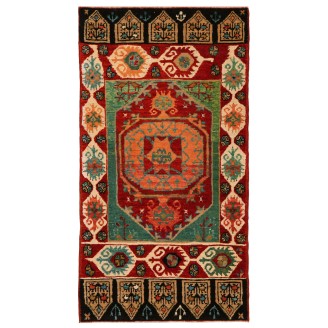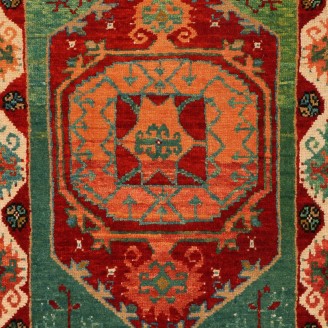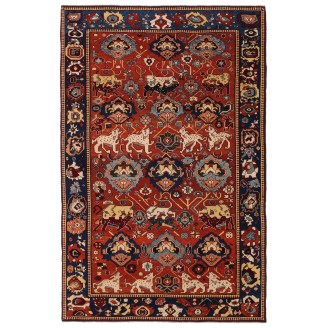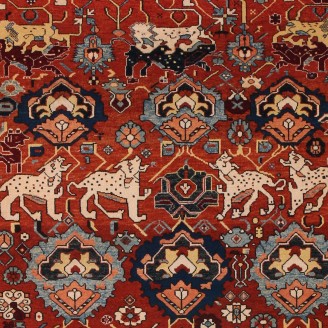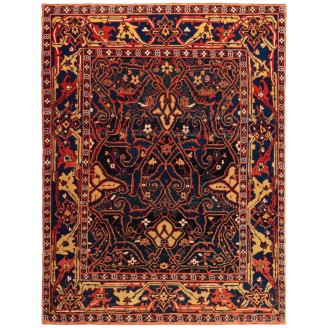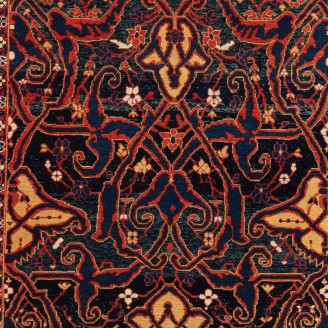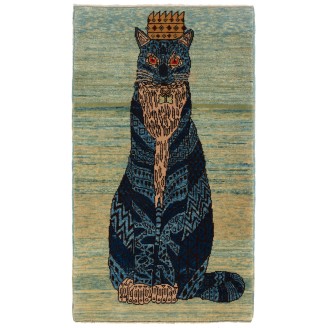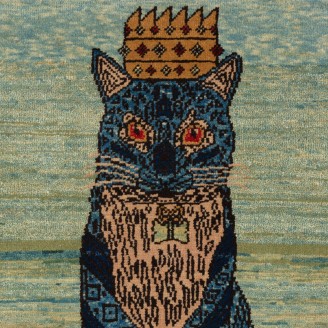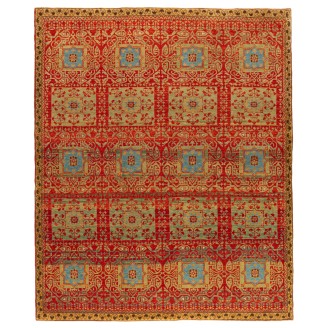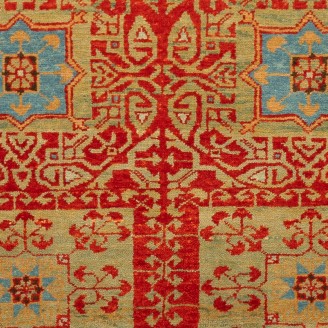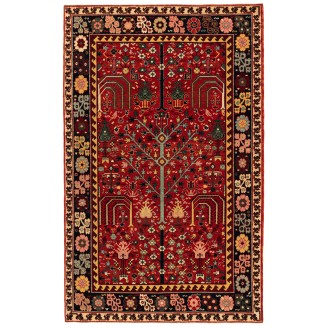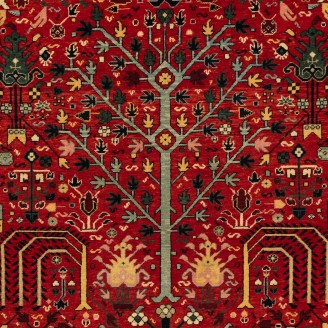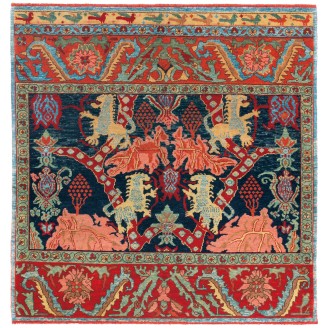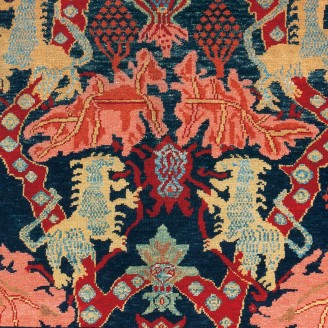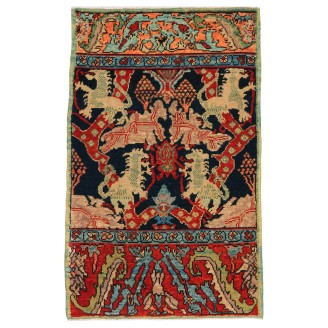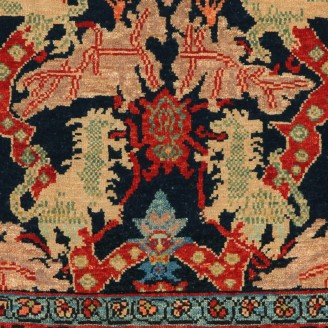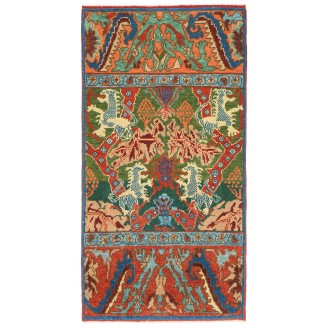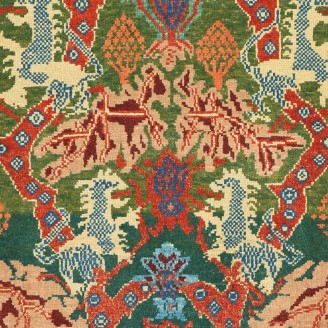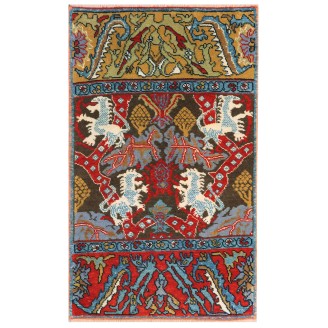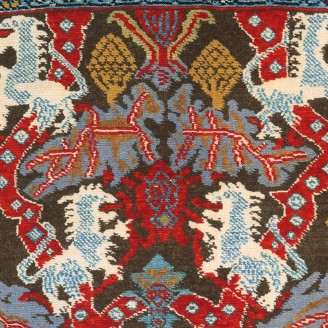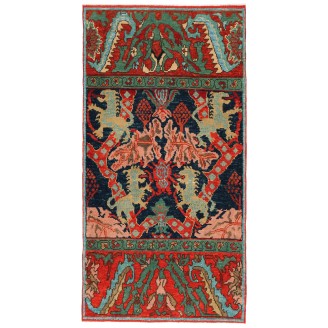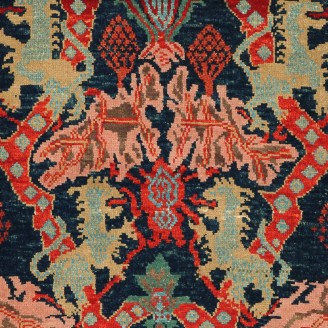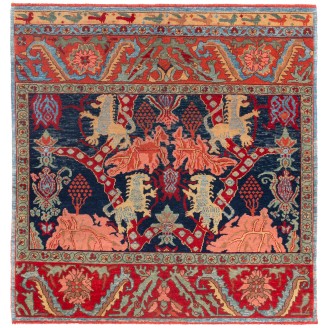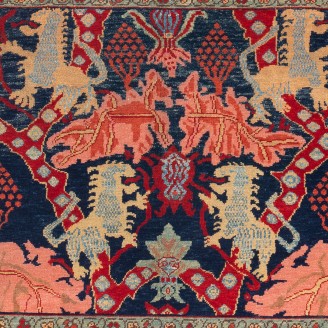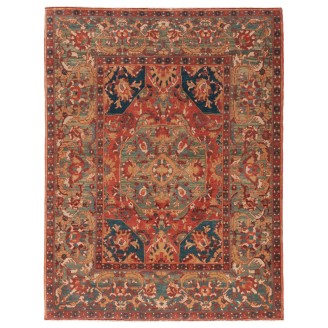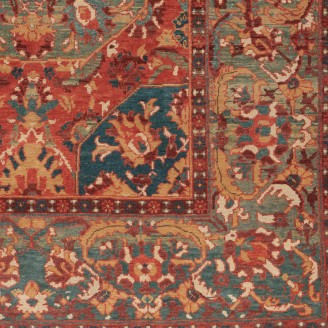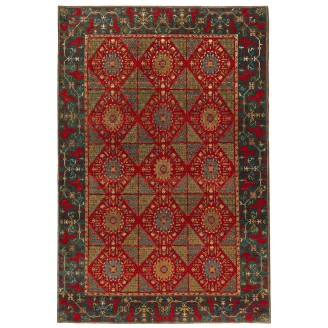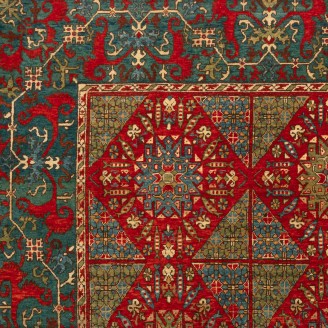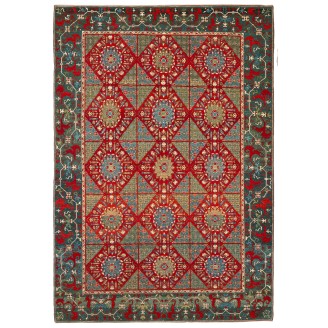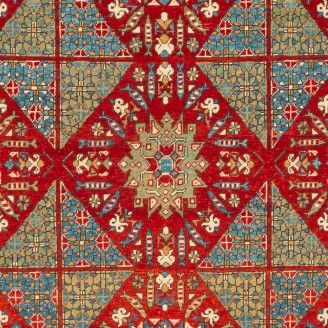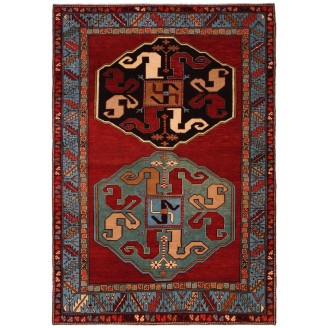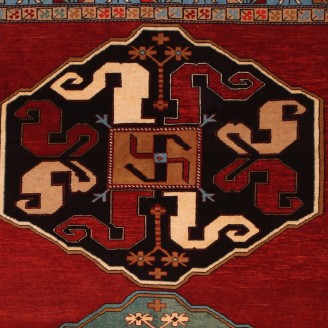Model: ARTK0031
Dimensions: 6'6" X 8'6"(199cm x 260cm)
The source of the rug comes from the book Orient Star – A Carpet Collection, E. Heinrich Kirchheim, Hali Publications Ltd, 1993 nr.7. This rug is from the late 19th century, Kazak region, Caucasus area. The Akstafa design reminds the basic principles of Star Kazaks, with the birds flanking the stars..
Price:
$0
Ex Tax:$0
Model: ART00025
Dimensions: 3'11" X 5'4"(120cm x 165cm)
The source of the rug comes from the book Orient Star – A Carpet Collection, E. Heinrich Kirchheim, Hali Publications Ltd, 1993 nr.7. This rug is from the late 19th century, Kazak region, Caucasus area. The Akstafa design reminds the basic principles of Star Kazaks, with the birds flanking the stars..
Price:
$4,900
Ex Tax:$4,900
Model: ART00410
Dimensions: 4'0" X 6'5"(122cm x 196cm)
The source of carpet comes from the book Orient Star - A Carpet Collection, E. Heinrich Kirchheim, Hali Publications Ltd, 1993 nr.178. This is an unusual border drawing, medallion carpet design 16th-century carpet from the Konya region, Central Anatolia area, Turkey. A detail in the border drawing i..
Price:
$2,700
Ex Tax:$2,700
Model: ART00074
Dimensions: 1'9" X 3'4"(54cm x 102cm)
This small piece of rug exhibits a forceful design on a small scale in a small area. These kinds of small Turkish yastiks or mats are found which contain an extraordinary amount of power within a very small space. There is a large octagon medallion in the center-so large it almost touches the edge o..
Price:
$650
Ex Tax:$650
Model: ART00206
Dimensions: 1'8" X 3'2"(51cm x 98cm)
This small piece exhibits a forceful design on a small scale in a small area. These kinds of small Turkish yastiks or mats are found which contain an extraordinary amount of power within a very small space. There are diagonal ascending rows of flowers covering the field. Even though the central moti..
Price:
$825
Ex Tax:$825
Model: ART00064
Dimensions: 1'7" X 3'0"(50cm x 93cm)
This small piece exhibits a forceful design on a small scale in a small area. These kinds of small Turkish yastiks or mats are found which contain an extraordinary amount of power within a very small space. A large octagon medallion in the center is so large that it almost touches the edge of the fi..
Price:
$825
Ex Tax:$825
Model: ART00289
Dimensions: 4'9" X 7'2"(145cm x 219cm)
The source of carpet comes from the book Orient Star - A Carpet Collection, E. Heinrich Kirchheim, Hali Publications Ltd, 1993 nr.81. This is an example of one of the most intriguing design groups of carpets from the Caucasus and North-west Persia area, and surrounding regions 17th to 18th century. ..
Price:
$5,900
Ex Tax:$5,900
Model: ART00232
Dimensions: 4'9" X 6'3"(147cm x 191cm)
The source of the rug comes from the book Antique Rugs of Kurdistan A Historical Legacy of Woven Art, James D. Burns, 2002 nr.33. This is a fine Kurdish workshop rug with split-palmette and trefoil arabesque patterns designed mid-19th century rug from Senna or Garrus, Eastern Kurdistan area. This de..
Price:
$5,200
Ex Tax:$5,200
Model: ART00525
Dimensions: 1'11" X 3'4"(60cm x 102cm)
Color summary: 8 colors of total; Moss Green 27 (Spurge - Indigo) Dark Brawn 316 (No Dye - Sheep’s own Color) Dark Sky Blue 23 (Indigo) Burlywood 135 (Spurge - Madder Root) Gunmetal Blue 409 (Indigo) Sunray Color 405 (Henna) Imperial Red 415 (Madder Root) Pale Green 439 (Chamomile - I..
Price:
$3,500
Ex Tax:$3,500
Model: ART00143
Dimensions: 4'9" X 5'9"(146cm x 177cm)
The source of the rug comes from the Baillet-Latour Mamluk Carpet, Vienna Book(1892) and Sarre-Trenkwald(1926, pl.48). This rug was designed in the early 16th-century rug by Mamluk Sultane of Cairo, Egypt. This carpet was sold at Christie's London on 8 April 2014 and purchased by the Louvre Museum. ..
Price:
$4,300
Ex Tax:$4,300
Model: ART00476
Dimensions: 4'10" X 7'8"(149cm x 235cm)
The source of the rug comes from the book Antique Rugs of Kurdistan A Historical Legacy of Woven Art, James D. Burns, 2002 nr.45. This is a popular design employed by the Kurds, called bid majnum (or Bid Majnun, weeping willow) 17th-century rug from Sa'uj Bulagh, Eastern Kurdistan area. Four differe..
Price:
$6,500
Ex Tax:$6,500
Model: ARTK0009
Dimensions: 3'6" X 3'8"(109cm x 113cm)
This offset pattern is composed of leaves and lotus palmettes filling the various compartments against the imposing ground, while heraldic lions rear across the strapwork borders. One has the impression that it is only part of a larger scheme designed 19th-century rug from Bidjar region, Eastern Kur..
Price:
$0
Ex Tax:$0
Model: ART00067
Dimensions: 1'6" X 2'5"(47cm x 75cm)
This offset pattern is composed of leaves and lotus palmettes filling the various compartments against the imposing ground, while heraldic lions rear across the strapwork borders. One has the impression that it is only part of a larger scheme designed 19th-century rug from Bidjar region, Eastern Kur..
Price:
$950
Ex Tax:$950
Model: ART00068
Dimensions: 1'9" X 3'4"(54cm x 104cm)
This offset pattern is composed of leaves and lotus palmettes filling the various compartments against the imposing ground, while heraldic lions rear across the strapwork borders. One has the impression that it is only part of a larger scheme designed 19th-century rug from Bidjar region, Eastern Kur..
Price:
$550
Ex Tax:$550
Model: ART00100
Dimensions: 1'8" X 2'9"(52cm x 85cm)
This offset pattern is composed of leaves and lotus palmettes filling the various compartments against the imposing ground, while heraldic lions rear across the strapwork borders. One has the impression that it is only part of a larger scheme designed 19th-century rug from Bidjar region, Eastern Kur..
Price:
$500
Ex Tax:$500
Model: ART00070
Dimensions: 1'9" X 3'5"(54cm x 105cm)
This offset pattern is composed of leaves and lotus palmettes filling the various compartments against the imposing ground, while heraldic lions rear across the strapwork borders. One has the impression that it is only part of a larger scheme designed 19th-century rug from Bidjar region, Eastern Kur..
Price:
$650
Ex Tax:$650
Model: ART00021
Dimensions: 3'6" X 3'8"(109cm x 113cm)
This offset pattern is composed of leaves and lotus palmettes filling the various compartments against the imposing ground, while heraldic lions rear across the strapwork borders. One has the impression that it is only part of a larger scheme designed 19th-century rug from Bidjar region, Eastern Kur..
Price:
$3,450
Ex Tax:$3,450
Model: ART00012
Dimensions: 4'0" X 5'2"(123cm x 158cm)
Turkish Court Manufactury Rugs were woven in the Egyptian workshops founded by Ottoman Empire in the 16th century. Those carpets were woven in Egypt, following the paper cartoons probably created in Istanbul and sent to Cairo at that time.The source of carpet comes from the book Antique Rugs from th..
Price:
$4,900
Ex Tax:$4,900
Model: ART00359
Dimensions: 6'1" X 9'1"(187cm x 278cm)
The source of carpet comes from the book Islamic Carpets, Joseph V. McMullan, Near Eastern Art Research Center Inc., New York 1965 nr.28. The field of the so-called "Chessboard" Carpet ( so-called Checkerboard Rug ) is usually applied on a vermillion ground and divided into rectangular compartments,..
Price:
$14,600
Ex Tax:$14,600
Model: ART00200
Dimensions: 6'1" X 8'9"(186cm x 267cm)
The source of carpet comes from the book Islamic Carpets, Joseph V. McMullan, Near Eastern Art Research Center Inc., New York 1965 nr.28. The field of the so-called "Chessboard" Carpet ( so-called Checkerboard Rug ) is usually applied on a vermillion ground and divided into rectangular compartments,..
Price:
$8,600
Ex Tax:$8,600
Model: ART00385
Dimensions: 5'0" X 7'1"(153cm x 217cm)
The source of the rug comes from the book Tapis du Caucase - Rugs of the Caucasus, Ian Bennett & Aziz Bassoul, The Nicholas Sursock Museum, Beirut, Lebanon 2003, nr.26-27. This is a famous design group of rugs with two medallions from the 19th century, Chondzoresk (meaning 'the little apple', a ..
Price:
$3,300
Ex Tax:$3,300
